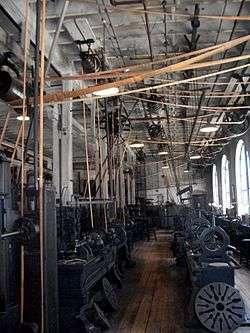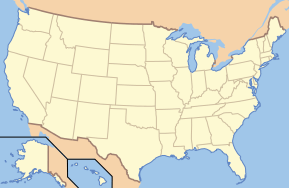Thomas Edison National Historical Park
|
Thomas Edison National Historical Park | |
|
Thomas Edison's Laboratory | |
 | |
| Location | 37 Honeysuckle Ave, West Orange, New Jersey 07052 |
|---|---|
| Coordinates | 40°47′09.46″N 74°14′24.42″W / 40.7859611°N 74.2401167°WCoordinates: 40°47′09.46″N 74°14′24.42″W / 40.7859611°N 74.2401167°W |
| Area | 21.25 acres (8.60 ha)[1] |
| Built | 1887 |
| Architect | H. Hudson Holly |
| Architectural style | Late Victorian, Queen Anne |
| Visitation | 55,284 (2011) |
| Website | Thomas Edison National Historical Park |
| NRHP Reference # | 66000052[2] |
| Significant dates | |
| Added to NRHP | October 15, 1966 |
| Designated NHS | September 5, 1962 |
| Designated NHP | March 30, 2009 |
Thomas Edison National Historical Park preserves Thomas Edison's laboratory and residence, Glenmont, in Llewellyn Park in West Orange in Essex County, New Jersey, United States. For more than 40 years, the laboratory had a major impact on the lives of people worldwide. Out of the West Orange laboratories came the motion picture camera, improved phonographs, sound recordings, silent and sound movies and the nickel-iron alkaline electric storage battery.
The history of how the site became a National Historical Park is complicated. Edison's home was designated as the Edison Home National Historic Site on December 6, 1955. The laboratory was designated as Edison Laboratory National Monument on July 14, 1956. On September 5, 1962, the 21-acre (85,000 m2) site containing the home and the laboratory were designated the Edison National Historic Site and overseen by the National Park Service.[1] On March 30, 2009, it was renamed Thomas Edison National Historical Park, adding "Thomas" to the title in hopes to relieve confusion between the Edison sites in West Orange and Edison, New Jersey.[3] Following extensive renovations of the laboratory complex, there was a grand reopening on October 10, 2009.
In popular culture
In 1996, the alternative rock band They Might Be Giants recorded four songs on phonograph cylinder at the museum. One of these recordings, of the song "I Can Hear You", appeared on their album Factory Showroom released later the same year. The other three songs ("Maybe I Know", "The Edison Museum", and a re-recording of the Factory Showroom track "James K. Polk") were released on the band's website in 2002.


See also
- Edison's Black Maria
- Thomas Alva Edison Memorial Tower and Museum
- National Register of Historic Places listings in Essex County, New Jersey
- Edison Storage Battery Company Building
- List of museums in New Jersey
References
- 1 2 "Edison Park Management". National Park Service. Retrieved 2009-08-16.
- ↑ National Park Service (2009-03-13). "National Register Information System". National Register of Historic Places. National Park Service.
- ↑ "ACT COMMEMORATING THE LITE, OR LIFETIME INNOVATIONS OF THOMAS EDISON". Congressional Record. February 28, 2006. Retrieved 2009-08-16.
External links
- Thomas Edison National Historical Park - official site
- Stained glass restoration National Park Service
- Thomas Edison National Historical Park, National Park Service at Google Cultural Institute
- Historic American Buildings Survey (HABS) No. NJ-729, "Glenmont, Llewellyn Park, West Orange, Essex County, NJ", 31 photos, 13 measured drawings, 12 data pages
- HABS No. NJ-729-A, "Glenmont, Gardener's Cottage and Greenhouse"
- HABS No. NJ-729-B, "Glenmont, Barn"
- HABS No. NJ-729-C, "Glenmont, Concrete Garage"
- HABS No. NJ-729-D, "Glenmont, Pump House"
- Historic American Engineering Record (HAER) No. NJ-70, "Thomas A. Edison Laboratories"
- HAER No. NJ-70-A, "Thomas A. Edison Laboratories, Building No. 2"
- HAER No. NJ-70-B, "Thomas A. Edison Laboratories, Building No. 3"
- HAER No. NJ-70-C, "Thomas A. Edison Laboratories, Building No. 5"
- The Invention Factory: Thomas Edison's Laboratories, a National Park Service Teaching with Historic Places (TwHP) lesson plan

